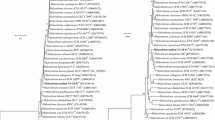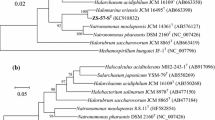Abstract
Two extremely halophilic archaeal strains GX1T and GX60 were isolated from the Gangxi marine solar saltern, China. Cells from the two strains were observed to be rod-shaped and stained Gram-negative, with red-pigmented colonies. Strains GX1T and GX60 were found to be able to grow at 25–50 °C (optimum 37 °C), at 1.4–4.8 M NaCl (optimum 2.6 M), at pH 5.5–9.5 (optimum pH 7.0) and neither strain required Mg2+ for growth. The cells lysed in distilled water and the minimal NaCl concentration to prevent cell-lysis was found to be 8 % (w/v). The major polar lipids of the two strains were identified as phosphatidic acid, phosphatidylglycerol, phosphatidylglycerol phosphate methyl ester, phosphatidylglycerol sulfate and three glycolipids chromatographically identical to those of Haloarchaeobius iranensis IBRC-M 10013T. 16S rRNA gene analysis revealed that each strain had two dissimilar 16S rRNA genes and both strains were phylogenetically related to Hab. iranensis IBRC-M 10013T (94.9–98.9 % nucleotide identity). The rpoB′ gene similarity between strains GX1T and GX60, and between these strains and Hab. iranensis IBRC-M 10013T were found to be 99.6, 96.0 and 95.8 %, respectively. The DNA G + C content of strain GX1T and GX60 were determined to be 67.7 and 67.8 mol %, respectively. The DNA–DNA hybridization value of strains GX1T and GX60 was 86 % and the two strains showed low DNA–DNA relatedness with Hab. iranensis IBRC-M 10013T (38 and 32 %). It was concluded that strain GX1T (= CGMCC 1.10390T = JCM 17114T) and strain GX60 (= CGMCC 1.10389 = JCM 17120) represent a new species of Haloarchaeobius, for which the name Haloarchaeobius litoreus sp. nov. is proposed.

Similar content being viewed by others
References
Cui H-L, Lin Z-Y, Dong Y, Zhou P-J, Liu S-J (2007) Halorubrum litoreum sp. nov., an extremely halophilic archaeon from a solar saltern. Int J Syst Evol Microbiol 57:2204–2206
Cui H-L, Zhou PJ, Oren A, Liu S-J (2009) Intraspecific polymorphism of 16S rRNA genes in two halophilic archaeal genera, Haloarcula and Halomicrobium. Extremophiles 13:31–37
Cui H-L, Gao X, Yang X, Xu X-W (2010) Halorussus rarus gen. nov., sp. nov., a new member of the family Halobacteriaceae isolated from a marine solar saltern. Extremophiles 14:493–499
Cui H-L, Yang X, Mou Y-Z (2011) Salinarchaeum laminariae gen. nov., sp. nov.: a new member of the family Halobacteriaceae isolated from salted brown alga Laminaria. Extremophiles 15:625–631
De Ley J, Cattoir H, Reynaerts A (1970) The quantitative measurement of DNA hybridization from renaturation rates. Eur J Biochem 12:133–142
Dussault HP (1955) An improved technique for staining red halophilic bacteria. J Bacteriol 70:484–485
Gonzalez C, Gutierrez C, Ramirez C (1978) Halobacterium vallismortis sp. nov. an amylolytic and carbohydrate-metabolizing, extremely halophilic bacterium. Can J Microbiol 24:710–715
Gutiérrez C, González C (1972) Method for simultaneous detection of proteinase and esterase activities in extremely halophilic bacteria. Appl Microbiol 24:516–517
Huß VAR, Festl H, Schleifer KH (1983) Studies on the spectrophotometric determination of DNA hybridization from renaturation rates. Syst Appl Microbiol 4:184–192
Makhdoumi-Kakhki A, Amoozegar MA, Bagheri M, Ramezani M, Ventosa A (2012) Haloarchaeobius iranensis gen. nov., sp. nov., an extremely halophilic archaeon isolated from a saline lake. Int J Syst Evol Microbiol 62:1021–1026
Marmur J, Doty P (1962) Determination of the base composition of deoxyribonucleic acid from its thermal denaturation temperature. J Mol Biol 5:109–118
McDade JJ, Weaver RH (1959) Rapid methods for the detection of gelatin hydrolysis. J Bacteriol 77:60–64
Minegishi H, Kamekura M, Itoh T, Echigo A, Usami R, Hashimoto T (2010) Further refinement of Halobacteriaceae phylogeny based on the full-length RNA polymerase subunit B′ (rpoB ′) gene. Int J Syst Evol Microbiol 60:2398–2408
Oren A, Ventosa A, Grant WD (1997) Proposed minimal standards for description of new taxa in the order Halobacteriales. Int J Syst Bacteriol 47:233–238
Stackebrandt E, Goebel BM (1994) Taxonomic note: a place for DNA–DNA reassociation and 16S rRNA sequence analysis in the present species definition in bacteriology. Int J Syst Bacteriol 44:846–849
Tamura K, Peterson D, Peterson N, Stecher G, Nei M, Kumar S (2011) MEGA5: molecular evolutionary genetics analysis using maximum likelihood, evolutionary distance, and maximum parsimony methods. Mol Biol Evol 28:2731–2739
Acknowledgments
This work was supported by the National Natural Science Foundation of China (No. 31370054), the grant from China Ocean Mineral Resources R & D Association (COMRA) Special Foundation (DY125-15-R-03), the Qinglan Project of Jiangsu Province and a project funded by the Priority Academic Program Development of Jiangsu Higher Education Institutions (PAPD). We are grateful to Dr. M. A. Amoozegar for kindly providing strain Haloarchaeobius iranensis IBRC-M 10013T.
Author information
Authors and Affiliations
Corresponding author
Electronic supplementary material
Below is the link to the electronic supplementary material.
Rights and permissions
About this article
Cite this article
Zhang, WJ., Cui, HL. Haloarchaeobius litoreus sp. nov., isolated from a marine solar saltern. Antonie van Leeuwenhoek 105, 1085–1090 (2014). https://doi.org/10.1007/s10482-014-0166-8
Received:
Accepted:
Published:
Issue Date:
DOI: https://doi.org/10.1007/s10482-014-0166-8




